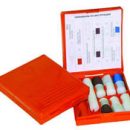Manifestations of acute radiation disease depend on the power of radiation exposure. The higher the dose of radiation, the earlier the main symptoms of the disease are developing more. Depending on the damage of organs and systems, several forms of radiation sickness are distinguished, most often found with the predominant lesion of the gastrointestinal tract, the blood system and the central nervous system.
Content
The main manifestations of acute radiation disease
 Manifestations of acute radiation disease directly depend on the dose of irradiation. At a dose of 1 Gray, an asymptomatic course of the disease is observed, with doses of about 30-50 Gray and more occurs. Immediately after irradiation, the so-called primary reaction appears. The symptoms of the primary reaction to irradiation are made up of nausea and vomiting (30-90 minutes after irradiation), headaches, weakness.
Manifestations of acute radiation disease directly depend on the dose of irradiation. At a dose of 1 Gray, an asymptomatic course of the disease is observed, with doses of about 30-50 Gray and more occurs. Immediately after irradiation, the so-called primary reaction appears. The symptoms of the primary reaction to irradiation are made up of nausea and vomiting (30-90 minutes after irradiation), headaches, weakness.
With doses of less than 1.5 Gray, these phenomena may be absent, at higher doses they arise and the degree of their severity are the greater the higher the dose. Nausea, which can be limited to the primary reaction at a light degree of illness, is replaced by vomiting, with an increase in the dose of irradiation, vomiting acquires a multiple character. This dependence is somewhat disrupted when radionuclides getting into the body from the radioactive cloud. In this case, vomiting may be multiple, stubborn even at a dose close to 2 Gray. Sometimes the victims mark the metal taste in the mouth.
With doses above 4-6 Gray of external irradiation there are transient redness of the skin and mucous membranes, the swelling of the mucous membrane of the cheeks, the tongue with light fingerprints of the teeth on it. When irradiated from a radioactive cloud when different components of radiation lesion are simultaneously affected by the skin and mucous membranes, when inhaled radioactive gases and aerosols, the appearance of rinopharygitis (damage to the mucous membrane of the nose and larynx), conjunctivitis, radiation erythema, even with a developing acute radiation disease, easy degree.
Gradually, for several hours, all manifestations of the primary reaction subscribe, the vomiting ends, the headache decreases, the redness of the skin and mucous membranes disappears. The well-being of patients is improved, although there is a pronounced weakness and very fast fatigue. If the irradiation is external combined with the ingress of radionuclides inward, directly acting on the mucous membrane of the respiratory tract and intestines, then in early days after irradiation there may be a liquid chair several times a day.
All these phenomena (the first signs of radiation sickness) in the coming days are held, but after a certain time they appear again as the main and very dangerous signs of acute radiation disease. At the same time, in addition to quantitative interrelations between the dose and the effect, there is another characteristic phenomenon characteristic of the dose and effect - the higher the dose, the earlier there will be a specific biological effect. This phenomenon is that the prime-specific vomiting with a large dose occurs earlier, the main signs of the disease: radiation stomatitis, enteritis, the drop in the number of leukocytes, platelets with all their patterns, epilation, leather damage, etc.NS. - appear the earlier than the above dose. The described phenomenon received the title «Dose - Effect Time», which plays a crucial role in biological dosimetry.
Many victims without strict doses in the first days of illness can be noted the transient increase in the spleen. The decay of red bone marrow cells may be due to the light yellowness of the scool and increasing the level of indirect bilirubin in the blood, which indicates the damage to the liver. The following forms of radiation sickness are distinguished:
Acute radiation disease with damage to the bleeding system
Doses over 100 happy cause bone marrow form of acute radiation sickness of different gravity. With this form, the main manifestations and the outcome of the disease are mainly due to the degree of damage to blood formation. Doses of single overall irradiation Over 600 are considered fatal, death occurs in terms of 1 to 2 months after irradiation. With the most typical form of acute radiation sickness, in the first, after a few minutes or hours, the initial reactions (nausea, vomiting, general weakness) appear at the dose. After 3-4 days, the symptoms substed, the period of imaginary well-being. However, with a thorough examination, the further development of the disease is detected. This period lasts from 14-15 days to 4-5 weeks. Subsequently worsens a general condition, weakness increases, hemorrhages appear, the body temperature rises. The number of leukocytes in peripheral blood after a short-term increase is progressively decreased, falling (due to the lesion of blood-forming organs) to extremely low digits (radiation leukopenia), which predisposes to the development of sepsis and hemorrhages. The duration of this period is 2-3 weeks.
Intestinal form of the disease
With overall radiation in doses of 1000 to 5000, an intestinal form of acute radiation disease is developing, which is predominantly lesion of the intestine, leading to a violation of water-salt metabolism (from abundant diarrows), and circulatory disruption. There are manifestations in the form of radiation stomatitis, gastritis, colitis, esophagitis, etc. A man in this form usually dies during the first day, bypassing the usual phases of radiation disease.
Cerebral form of acute radiation disease
After overall irradiation in doses over 5000, death occurs after 1-3 days or even at the moment of irradiation from damage to the tissues of the brain (this form of radiation disease is called cerebral). Characteristic symptoms of the disease is the workload, fast depletion, then confusion occurs and loss of consciousness may develop. Patients die at the phenomena of the brain coma in the early hours after irradiation.









